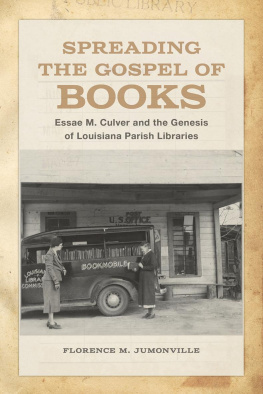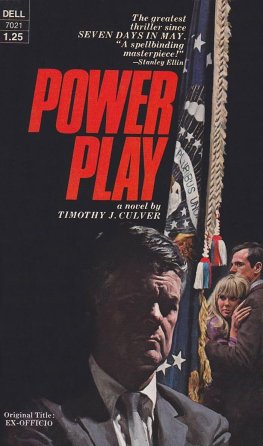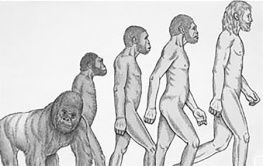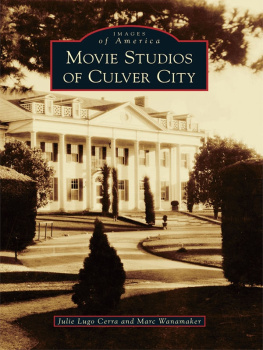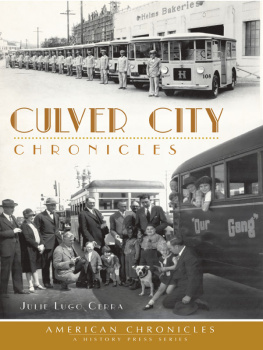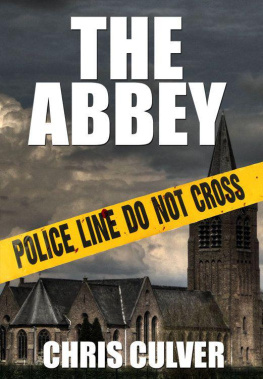PREFACE
In the 1920s, libraries were beyond the experience of most rural residents. To encourage their establishment and the spread of good books throughout rural America, in 1925 the Carnegie Corporation offered grant funding to a state deficient in library development. The purpose of the grant was to enable that state to create a model program, demonstrating to other states the benefits to be gained by an exemplary library commission with an aggressive, actively administered program of field work. This, in turn, would demonstrate to rural residents how libraries and the books they lent could enhance peoples lives. Because Louisiana received the funding, its parish libraries evolved differently from county libraries in other states. Essae M. Culver, an experienced librarian who had worked in rural Oregon and California, was recruited to direct the project. She adapted the California plan of library development in ways that enhanced demonstration libraries prospects for success, and, in time, the Louisiana plan became an exemplar for the nation and for foreign countries. Spreading the Gospel of Books chronicles the history of the Louisiana Library Commission and its successor agency, the State Library of Louisiana, from the commissions inception in 1920 through the administrations of the first two state librarians, Essae M. Culver (19251962) and Sallie Farrell (19621975).
When I was attending library school at Louisiana State University (LSU) during the 197172 academic year, Miss Essae, as she was widely known, was still living, and, among Louisiana librarians, at least, she was legendary. All of my teachers knew her, some had worked with her, and they spoke of her with combined respect and affection that verged on reverence. We students quickly learned the story of how she came from California to organize Louisiana parish libraries, spreading the gospel of books to the most remote areas of the state.
At the time, LSU held graduate - level library science classes in the library. One morning, word spread that Miss Essae was in the building. When the class had assembled, the professor Thomas Shaw, formerly head of reference at the Library of Congress entered the room smiling and announced that he had a surprise for us. He retreated into the corridor and returned a moment later, escorting Miss Essae on his arm. She spoke to us throughout the fifty - minute class period. I have forgotten what she talked about probably her early experiences in Louisiana, with which I was familiar already. What I remember, all these years later, is that when class ended, she seemed to be sizing us up as we filed past her, appraising the aspiring librarians who would carry on the work. She died less than a year later.
In 1998 I attended a Louisiana Library Association committee meeting at the State Library. Two of my friends there, Judy Smith and Virginia Smith, invited me to join them for lunch after the meeting. In a nearby restaurant, they admitted to having an ulterior motive. Did you know, they asked, that we have Miss Essaes journals? (No, I didnt.) Judy and Virginia thought that someone should use the journals for researching the State Librarys history and they had me in mind. Back at the Louisiana Collection after lunch, they showed me the journals, and they were right: the small volumes contained a wealth of information.
From the pages of those journals, and from correspondence, scrapbooks, reports, and comments of her contemporaries, Culver emerges as a woman of culture and diverse interests, an able administrator, a fun - loving chum, and a caring friend, as well as a devoted and dynamic librarian whose imagination, dedication, compassion, and tireless crusading spread libraries throughout rural Louisiana between 1925 and 1968. I drew upon the journals as I wrote a paper I presented to the American Library Associations Library History Round Table the next year. That paper led to another, and, two papers and one article later, I recognized that they should grow up to be a book. Thomas Jaques, Louisianas third state librarian, approved the project and gave me total access to any file I wished to read and any employee I wanted to interview. His successor, Rebecca Hamilton, welcomed me equally. This research would not have been possible without Judy and Virginia, who proposed it; Tom and Rebecca, who supported it; and the State Library personnel who facilitated it, especially Judy in her capacity as Louisiana Collection librarian and her successor, Charlene Bonnette; Dorothy White; and the staff of the Office of the State Librarian.
Much of the writing occurred during a six - month sabbatical leave from the University of New Orleans, and I am appreciative of the support of Dean of Library Services Sharon Mader and my colleagues in the Louisiana and Special Collections Department, who made possible not only the sabbatical but also release time for months of trips to Baton Rouge every other Friday.
In addition, I am indebted to the late Honorable John C. Culver, former United States senator from Iowa, and his sister, Kay Baty, for generously providing invaluable information about their aunt Essaes childhood and Culver family history; also to Sonja Somerville of the Salem Public Library, for exhuming forgotten records of Miss Essaes employment there. Gracious assistance with the photographs that illustrate this volume came from Charlene Bonnette (State Library of Louisiana); Melissa Eastin (East Baton Rouge Parish Library); Fermand M. Garlington II and Laura L. McLemore (Louisiana State Library in Shreveport); Heather Pilcher (University of Louisiana at Monroe); Scott T. Jordan (University of Louisiana at Lafayette); Connie L. Phelps and James W. Hodges (University of New Orleans); Rebecca Smith, Heather M. Szafran, and Michael M. Redmann (The Historic New Orleans Collection); Sara Chetney (Claremont Colleges Library); Cara Setsu Bertram (American Library Association Archives at the University of Illinois at Urbana - Champaign ); and Viktoria Mraz ( McGraw - Hill ).

